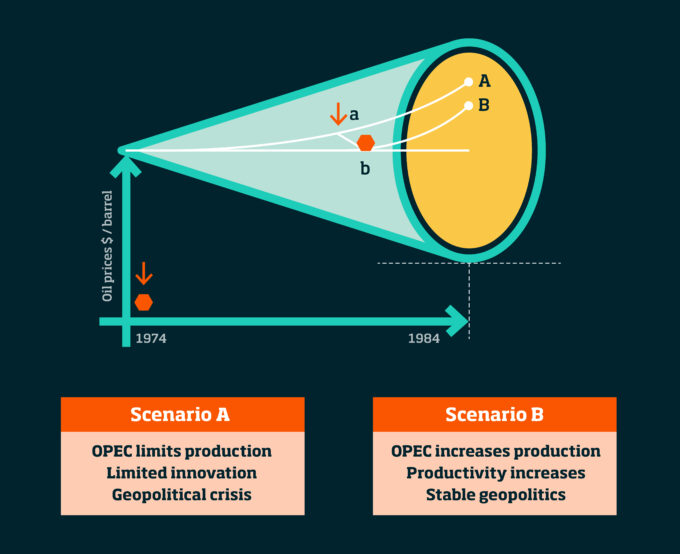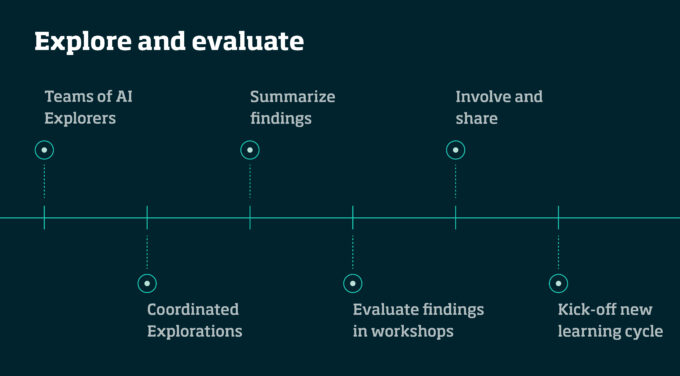
“We were so scared of our IPO”: Leaders Unplugged with former On-CEO Marc Maurer
Marc Maurer shares how ON grew from startup to IPO by defying hype, focusing on purpose, and leading with humility in this candid Leaders Unplugged episode....

by Stefan Michel Published December 8, 2023 in Strategy • 7 min read
AI-based technologies will change our lives, our businesses, and our societies – but the fact is, nobody knows to what extent, or even what the specifics will look like. While some aspects of the current hype around ChatGPT might disappear, the recent developments are substantial, multidimensional, and exponential, and create positive feedback loops that accelerate themselves.
Our world changed forever in the moment that Ashish Vaswani at Google and his co-authors published their paper “Attention is all you need” in 2017, suggesting a new machine learning architecture. That was the paper that enabled the development of transformers, on which all GPTs (generative pre-trained transformers) are based.
Generative AI has already changed jobs and processes, led to strikes, enabled new customer interactions, and forced governments to work on new regulations. The results of a representative research study I conducted in October 2023 among Swiss non-executive board members show that artificial intelligence ranks as the most crucial topic that boards must pay attention to. There is a clear consensus that both the benefits and risks of generative AI are vast.
Because the development of AI is based on technologies that indicate exponential progress, forecasts are impossible. This is especially true as developing technologies are interacting with each other. My thought experiment went like this: I researched a list of technologies that interact with the development of AI, which resulted in 24 entries (see box). In other words, we need to follow the trends of 24 technologies. If we now calculate (using ChatGPT-4) how many interactions 24 technologies have, we learn that there are 16,777,239 combinations of cross-fertilization that we should follow. Clearly, this is not possible, which poses a problem for strategy development.
Every strategy has three components. We must analyze and diagnose the external environment and our internal resources and capabilities. Once we can answer the question “What the heck is going on?” with a coherent narrative, we must identify choices involving significant strategic trade-offs. Finally, once we decide, we need to align the resources and actions within the organization.
Scenario planning is the established methodology to deal with uncertainty in the external environment. Scenario planning was developed within Shell about 50 years ago. The main unknown was the oil price development, which was affected by a set of other developments (see Figure 1).
Once the main scenarios are understood, strategic initiatives can be planned. These initiatives are proactive steps the organization can take to navigate or capitalize on the potential futures envisioned in the scenarios. Organizations often use the Three Horizons Framework by McKinsey to manage and prioritize these initiatives. This framework categorizes initiatives into three “horizons” based on their time frame and nature:

By mapping initiatives across these horizons, organizations have been able to balance their portfolios of strategies to maintain current operations while investing in future growth and innovation.
But here is the catch: Scenario planning is particularly effective when dealing with a single critical uncertainty, like oil prices, where varying prices can create different future states. This allows organizations to develop targeted strategies that respond to specific changes in that variable. The future of AI presents a vastly more complex challenge for scenario planning due to the many interrelated uncertainties involved.
This complexity makes it exceedingly difficult to construct scenarios that are coherent (internally consistent and believable), plausible (credible given what we know about the world), and likely (having a reasonable chance of occurring). The interactions between the numerous variables can lead to emergent behaviors and outcomes that are not readily foreseeable by extrapolating current trends.
AI technology inevitably leads to the biggest education initiative in the history of organizations. Because we just don’t know yet.
In my recent conversations with leaders in various industries (publishing, insurance, distribution, consulting, manufacturing, food processing), I learned that there are better ways to strategize for an AI future. Given that there are too many trends to predict a future with a useful likelihood, organizations must create an environment for learning.
This comes at the risk of “picking up the AI hammer to find AI nails,” as my friend Jim Pulcrano describes it. Nevertheless, diving in is inevitable, but should be done with a systematic approach, which I summarize with six guiding principles.

As we face the vast possibilities of AI, it’s clear that traditional ways of planning for the future, like scenario planning, don’t work anymore. The future of artificial intelligence is made up of many complex parts, with numerous technologies growing fast and affecting each other in ways we can’t predict.
Trying to guess what will happen using old methods is no longer helpful. Companies must switch to strategies that can change and grow as quickly as AI. This means following the ‘six E’ approach: educate, embrace, execute, evolve, explore, and evaluate.

Professor of Management and Dean of Faculty and Research
Professor Stefan Michel‘s primary research interests are AI’s impact on strategy, pricing, and customer-centricity. He has written 13 books, numerous award-winning articles and ranks among the top 40 bestselling case study authors worldwide by The Case Centre. He is currently Dean of Faculty and Research at IMD and is also Program Director for two IMD programs: the 10-day Breakthrough Program for Senior Executives (BPSE), guiding leaders in defining their next breakthrough; and Strategic Thinking, an 8-week online program with 1-1 coaching, helping professionals become better strategists while working on a concrete strategic initiative for their organizations.

July 8, 2025 • by Alyson Meister, Marc Maurer in Strategy
Marc Maurer shares how ON grew from startup to IPO by defying hype, focusing on purpose, and leading with humility in this candid Leaders Unplugged episode....

June 26, 2025 • by Michael Yaziji in Strategy
Forward-thinking leaders proactively shape their external environment, turn uncertainty into certainty, and create substantial value in the process....
 Audio available
Audio available
June 4, 2025 • by Stéphane J. G. Girod, David Branch in Strategy
The traditional e-commerce model is on its last legs. In a disrupted luxury landscape, brand leaders are shifting focus to unified commerce, hyper-personalization, and deeper digital storytelling to completely reinvent the customer...

June 3, 2025 • by Anna Cajot in Strategy
Donald Trump’s tariff tactics offer a bold case study in game theory in negotiations. By setting the rules early, limiting options, and projecting power through credible threats, his approach shows how negotiations...
Explore first person business intelligence from top minds curated for a global executive audience